
Recently on Cyclingnews.com |
L'Etape du Tour feature, Gap - L'Alpe d'Huez, part 3
L'Etape - hard to enter, harder to finish
L'Etape du Tour has been running since 1993, when participation rates were a fraction of the numbers today. There were very few foreigners in those early years, but the reputation of l'Etape has always been the same - it's hard to enter and even harder to finish. In part three of Mark Sharon's experience of l'Etape, he examines the short but colourful history of the event.
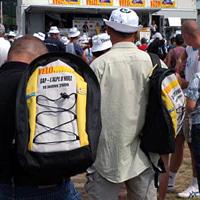
|
Part 1, Giving amateurs a flavour of the Tour, is
here.
Part 2, A failing sense of confidence, is
here.
Of the 1705 riders who started back in 1993 - a low turn-out, which was primarily due to the novelty of the race as much as anything - just 48 were foreigners. By the next year's edition, fought out between Lourdes and Luz Ardiden, the field had leapt to 4000. The race had caught the imagination of the French cycling community. Foreigners were still a very minor proportion though, numbering just a couple of hundred in all.
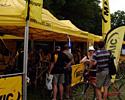
|
The race was quickly establishing a reputation for being both hard to enter and even harder to finish. In '94 just 61 percent of the starters reached the finishing line. This was nothing compared with the mammoth stage of '98, between Grenoble and Les Deux Alpes. Veterans of the event still shudder when they recall the 189km of unadulterated climbing that marked the event as the toughest ever - the Col de la Croix de Fer, Col de Telegraph, Col du Galibier and finally Les Deux Alpes - all tackled in searing heat. Of the 4638 starters just 2229 finished - a staggering 52 percent being culled by the sheer might of nature.The organisation lost its nerve temporarily the next year and opted for what was frankly a tedious plod across the Massif Central - 209km between Saint Galmier and Saint Flour. It is a wonder most people didn't abandon through boredom.
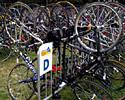
|
By 2000 the organisation had got back on track and heeded the calls to respect the tradition of the race - nobody wants to do the Etape du Tour because it is easy - and boy did race organiser Jean-Francois Alcan and his crew set us up for a dandy. What they hadn't counted on was nature once more demanding a big say in proceedings.On paper the race was short but sharp - 155km between Carpentras and Mont Ventoux - the latter a place of legends and tragedy. It was here on Friday 13, 1967, which just happened to be the 13th day of that year's Tour de France that Tommy Simpson found out to his cost that doping has its down side. Halfway up the mountain with the summit of the 1909m monster in sight Tommy toppled off his bike. Laced to the eye balls with amphetamines and brandy he had pushed his body past its limit. Despite an attempt to continue he fell again, and lost consciousness - he died the next day.

|
Few who started would not have spared a thought for Tommy - good or bad. By the end of the day Mont Ventoux had given us all another reason to fear it. The day started clear and fine, but on Mont Ventoux the temperature was dropping. Those at the very front managed to get across the top before things got bad, but those in the middle found themselves in near freezing temperatures, a product of the freaky weather conditions that often prevail on Mont Ventoux. Quickly realising the problem the organisation and gendarmes stopped the race at Café Reynard, but those already on the mountain had no choice but to battle on. The result was 700 people hospitalised with hypothermia - many dropping from their bikes unable to feel, let alone hold on to, the handlebars. Once more the Etape du Tour had delivered drama in huge measure - and nobody was complaining.
The 2000 edition was also notable for the number of foreign riders taking part, which had now passed the 1000 mark. It was also much harder to get in, with applications outstripping places by up to 20 percent.
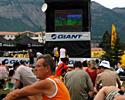
|
The organisation has obviously been trying to evolve the race, both in terms of the maximum number of entrants, which for the last three years has remained at 8500, and the way applications are handled. Until 2006 entry was basically a free for all, with some interesting quirks. The timetable for the race was as follows: Tour de France route announced in October, the route of the Etape du Tour announced in January, applications accepted from February.
That made for a very interesting situation. Nobody knew whether they were in until perhaps March and April but from October the speculation was rife. The premium was on accommodation so everyone, including the Tour companies, would block-book hotels in the three or four areas they thought the Etape would take place.
Over the last couple of years the organisation has started announcing the route of the Etape at the same press conference the Tour de France itself is unveiled in late October. This at least focused the scramble for accommodation on only one region. Yet, unless you were going with a tour company it was still necessary to speculate on accommodation, because applications and hence places were still not being accepted until February. To make matters worse the race was evermore over subscribed. In 2005 demand outstripped supply by over 100 percent according to rumours.
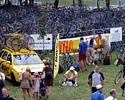
|
In 2006 the organisation brought in two policies to help smooth out the problems. First, the organisation instituted a lottery for places. Until 2006 applications were accepted on a first-come first-served basis, and were based on post-mark. Sounds reasonable, but the application form was in Velo Magazine which arrived in different places at different times. With in excess of 15,000 applications arriving within days of the forms appearing the situation was hopeless for some. For 2006, all applications received post-marked within the first fifteen days were entered into a ballot from which 6000 names would be drawn - simple, effective, at least so far. Why 6000? That was because the ballot only applied to French applicants.
The second policy is arguably a case of good intentions, bizarre results. All foreigners were told they had to go through officially nominated tour companies to whom around 2500 places were allocated. This has left people mystified. It means an Italian living 75km from Gap in NW Italy had to go through a tour company, but a Frenchman living in Rennes, 750km away didn't - bizarre.
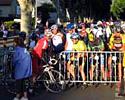
|
Many of those, myself included, who like to remain independent, feel that is just lining the pockets of the tour companies. Some companies give good value and do take the strain off organising at a distance. Others are quite honestly meat factories, bussing in riders to the start from 100km away, and charging a fortune for the privilege of starting the race tired. Unfortunately, there is no one way that will make everyone happy, and with over 2500 foreigners in the 2006 race, there has to be a way of levelling the playing field for domestic riders and foreigners alike.
While much of the race is becoming highly commercialized, which is sad for those of us who knew it from the beginning as a friendly, individual scale event, it is a case of "plus ca change" as they say! It is not an exclusive club and giving everyone a fair crack at it is very important.
In part 4, you've read the story, now watch the videos of Mark's Etape in glorious Cyclingnews HandleBarCamOVision.
Travel: Brittany Ferries - www.brittanyferries.com
Accommodation: Lawrie Cranley at www.bikestyletours.com
Frame: Giant Bicycle Company - www.giantbicycles.com
Saddle/Seatpost: Specialized UK - www.specialized.com
Handlebars/Stem: ITM - www.itm.it / www.jimwalker.co.uk
Groupset/Wheels: Campagnolo - www.campagnolo.com
Tyres and clothing: Continental - www.conti-tyres.co.uk
For a thumbnail gallery of these images, click here
Images by Mark Sharon and friends
- Road notice.
- Start village entrance arch.
- Author with dossard.
- Collecting race numbers.
- Checking names on the start list.
- Author and family checking names of friends.
- The lady who checks the timing.
- Information at the start village.
- Start village crowd around the information boards.
- Riders scrutinise the information boards.
- Crowd listening to the tombola being announced.
- Start village climbing wall.
- Local specialities at the start village.
- Queuing for the bike park.
- Bikes racked in the bike park.
- Mavic assistance at the start village.
- Start village sponsor stands.
- The Tour de France on the start village big screen.
- Entrance to the start village.
- Start village entertainers.
- Start village entertainer.
- Canadian patriotism.
- Start village sponsor stands.
- Start village bike park and Mavic assistance.
- Authors trusty steed.
- Outdoor privy before the start.
- Loo queue on race day.
- Riders await the start.
- Race day bike detail.
- View from the cockpit.
- Author awaits the start.
- Gathering for the depart.
- The peloton heads into the mountains.
- Heading into the morning sun on race day.
- The Lac de Serre Poncon'
- The sun also rises.
- 50km down 141 to go.
- Feedstop melee.
- Piles of oranges at the feedstop.
- 50km to the Col d'Izoard.
- Combes to Queyras.
- Combes to Queyras.
- Towards Col d'Izoard
- Peloton is strung out.
- Peloton tackles the Gorges.
- Author feels the heat.
- Mobbing a fountain.
- Brunissard at 80km.
- The peloton stretches back down the valley.
- Nearing the Col d'Izoard.
- On the Col d'Izoard.
- Entering the Casse Desserte.
- In the Casse Desserte.
- Approaching the summit of the Col d'Izoard.
- At the summit of the Col d'Izoard.
- One of the few women in the Peloton approaching the summit of the Col d'Izoard.
- The feed stop at Briancon resembles a war zone.
- The peloton heads towards the Col du Lautaret.
- Stocking up at a fountain on the Col du Lautaret.
- The never-ending trek up the Col du Lautaret
- Col du Lautaret just 2km to go.
- Near the Col du Lautaret with La Meije in the distance.
- At corner nine on Alpe d'Huez.
- Col du Lautaret riders jostle to fill water bottles.
- Alongside Lac du Chambon.
- The road across the Chambon dam.
- Riders cross the Barrage du Chambon.
- Foot of the Lac du Chambon.
- Descending the Col de Lautaret with 150km done.
- Descending the Col de Lautaret.
- Near Bourg d'Oisans.
- Last stretch near Bourg d'Oisans.
- Reaching the feed station at the foot of Alpe d'Huez.
- Alpe d'Huez first ramp.
- Corners on Alpe d'Huez.
- On Alpe d'Huez near corner 14.
- On Alpe d'Huez.
- Corner nine on Alpe d'Huez.
- Looking down on Huez en Oisans.
- Looking down Alpe d'Huez.
- Struggling up Alpe d'Huez.
- The corners of Alpe d'Huez.
- Alpe d'Huez jerseys for sale.
- The finishing straight.
- Riders in the finishing straight.
- Last 100 metres to the finish.
- Crowd at the finish.

